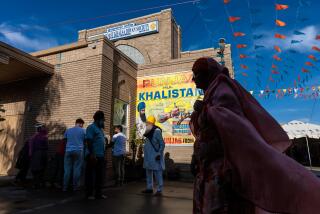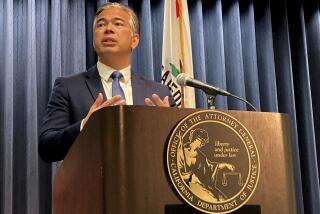Schools Sued for Barring Sikhs Wearing Ceremonial Knives : Courts: Merced County district officials say the symbolic weapons required by the children’s religion could cause injury. The ACLU counters that they are not weapons.
- Share via
SAN FRANCISCO — The ACLU on Friday sued a Merced County elementary school district on behalf of three Sikh children who were denied the right to wear ceremonial knives to class.
The children, two brothers and a sister ages 7, 8 and 10, have been barred from school since January because their religion requires them to wear the knives beneath their clothing 24 hours a day.
Officials of the Livingston Union School District say the knives, known as kirpans, could be used as weapons and thus are forbidden on school grounds. Carried in a wooden or metal sheath, the kirpans have blades that are three to four inches long.
“Our concern is for the safety of all our schoolchildren,” said Henry Escobar, assistant superintendent at the rural school district. “These kirpans are daggers, with steel blades. In the wrong hands they could be very dangerous.”
The children’s parents say the kirpan is one of five sacred symbols that must be worn at all times--even while bathing or sleeping--by baptized Khalsa Sikhs, who, like Orthodox Jews, follow strict religious traditions.
The kirpan, which represents a Khalsa Sikh’s duty to defend the weak and oppressed, is worn on a shoulder harness fastened at the waist by a sash. The other four symbols are long hair, a comb, a steel bracelet and special cotton undergarments. A Khalsa Sikh agrees to wear the symbols, known as the “Five Ks,” the day he or she is baptized.
“The kirpan is not a weapon,” said Stephen V. Bomse, a San Francisco attorney handling the case for the family and the American Civil Liberties Union. “It is a religious symbol. Wearing it at all times is as important to Khalsa Sikhs as wearing a yarmulke is to Orthodox Jews.”
Bomse argued that the kirpan is far less dangerous than other common school implements readily available to children, items such as scissors, pens and baseball bats. He said there have been no reported incidents of violence involving kirpans on school grounds in the United States.
“Schools unquestionably have legitimate concerns about violence,” Bomse said. “But Sikh children are well trained in their religious obligations. They know the kirpan is neither a toy nor a weapon.”
The lawsuit, filed in federal court in Fresno, claims that the school district’s action violates the children’s religious freedoms under a federal law passed late last year. The lawsuit seeks a policy change allowing pupils and their parents to wear kirpans while on school property, and requests money damages from the district for depriving the children of their education.
Several other California school districts recently adopted rules permitting kirpans under certain guidelines. In Yuba City, Supt. Lee Brittenham said officials have “disarmed the kirpan” by requiring it to be riveted to its sheath, which must have a blunted, enclosed tip.
“In this modified state, it is not a weapon,” said Brittenham, whose student population is about 12% Sikh. “We’ve managed to deal with the very critical safety concern and avoid infringing on people’s basic religious rights.”
Two districts--in Live Oak, north of Sacramento, and Selma, near Fresno--have adopted similar policies. A spokeswoman for the state Department of Education said she knew of no school district except Livingston that had banned kirpans.
Sikhism, which began in about 1500 in present-day Pakistan, was founded by Guru Nanak and grew out of Hindu culture. Today, there are about 500,000 Sikhs in the United States.
Besides the plaintiffs--Rajinder Singh Cheema, Jaspreet Singh Cheema and Sukhjinder Kaur Cheema--several other Sikh children have been sent home for wearing kirpans in Livingston schools. The others, Escobar said, have returned to school wearing miniature, symbolic kirpans around their necks.
More to Read
Sign up for Essential California
The most important California stories and recommendations in your inbox every morning.
You may occasionally receive promotional content from the Los Angeles Times.













